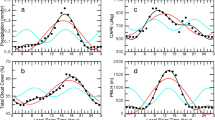Summary
For each month a linear regression equation has been derived for the relation between the daily sums of circumglobal and global radiation based on measurements at De Bilt during a period of two years. The goodness of fit of this relation is proved by comparison of the standard deviations of the differences of the calculated and observed daily sums and of the standard deviation of the monthly mean of the global radiation or of this mean itself. Using the period of observations from 0 to 24 hrs. one gets results which are 52 per cent less accurate than those from a period of observations from 8 to 8 hrs. If one estimates the daily sums of the global radiation by means of a linear relation to the relative duration of sunshine the standard deviation of the differences between calculated and observed daily sums is 2.5 times as large as in the first case.
From simultaneous measurements of the circumglobal radiation above a short grass mat (reflection coefficient 0.147 in the spectral region from 0.3 to 3.0 μ) and above a bare, sandy soil, rich in humus, the reflection coefficient of bare soil could be determined to 0.076 which is in good agreement to the results of other authors.
Zusammenfassung
Es werden lineare Regressionsgleichungen für alle Monate für die Beziehung zwischen den Tageswerten der Zirkumglobalstrahlung und der Globalstrahlung auf Grund von zweijährigen Messungen in De Bilt abgeleitet. Die Güte der Anpassung wird überprüft durch das Verhältnis der Streuung der Differenzen zwischen den beobachteten und berechneten Tagessummen der Globalstrahlung und der Streuung der Monatsmittel der Globalstrahlung oder diesem Mittel selbst. Die Verwendung der Beobachtungsperiode von 0 bis 24 Uhr führt zu einem um 52% schlechteren Ergebnis als die Periode von 8 bis 8 Uhr. Schätzt man die Tagessummen der Globalstrahlung mit Hilfe einer linearen Beziehung zur relativen Sonnenscheindauer, dann wird die Streuung der Differenzen zwischen berechneten und beobachteten Tagessummen 2,5 mal so groß wie im ersten Fall.
Aus gleichzeitigen Messungen der Zirkumglobalstrahlung über einer Grasmatte (Reflexionskoeffizient 0,147 im Spektralbereich 0,3 bis 3,0 μ) und über kahlem, sandigem, humusreichem Boden konnte der Reflexionskoeffizient des kahlen Bodens zu 0,076 bestimmt werden, was in guter Übereinstimmung mit den Resultaten anderer Autoren ist.
Résumé
Partant de mesures effectuées durant deux ans à De Bilt, l'auteur établit pour chaque mois des équations de régression linéaire pour la relation existant entre les valeurs journalières de la radiation globale et de la radiation sphérique. Il en contrôle l'exactitude au moyen du rapport existant entre la dispersion des différences des sommes journalières calculées et mesurées de la radiation globale et la dispersion des moyennes mensuelles ou de ces moyennes elles-mêmes. En partant d'une période d'observation de 0 à 24 heures, on obtient des résultats de 52% moins exactes qu'à partir de la période située entre 8 et 8 heures. Si l'on estime la somme journalière de la radiation totale au moyen d'une fonction linéaire de la durée de l'insolation relative, la dispersion des différences entre les sommes calculées et observées est 2,5 fois supérieure au cas précédent.
En mesurant simultanément la radiation sphérique sur un gazon (coefficient de réflexion 0,147 dans la bande située entre 0,3 et 3,0 μ) et sur un terrain nu, sablonneux et riche en humus, on a pu déterminer un coefficient de réflexion de 0,076 pour le sol nu, ce qui correspond bien aux valeurs indiquées par d'autres auteurs.
Similar content being viewed by others
References
Boer, H. J. de: A Calculation of Global Radiation in the Netherlands with the Aid of the Relative Duration of Sunshine. Arch. Met. Geoph. Biokl. B10, 537–546 (1961).
Courvoisier, P., andH. Wierzejewski: Das Kugelpyranometer Bellani. Arch. Met. Geoph. Biokl. B5, 413–446 (1954).
Boer, H. J. de: Onderlinge vergelijking van waarnemingen met drie bolpyranometers van Bellani. K. N. M. I., De Bilt, Verslagen V-30 (1958).
Boer, H. J. de: Eén jaar waarnemingen met de bolpyranometer volgens Bellani. K. N. M. I., De Bilt, Verslagen V-42 (1958).
Vries, D. A. de: Solar Radiation at Wageningen. Meded. L. H. S.55 (6), 277–304 (1955).
Schüepp, W.: La conversion du rayonnement sphérique en rayonnement global. Arch. Met. Geoph. Biokl. B10, 311–341 (1960).
Boer, H. J. de, enH. de Hart: Vergelijking van uitkomsten van metingen van de circumglobale straling boven gras en boven kale grond te De Bilt. K. N. M. I., De Bilt, Verslagen V-87 (1961).
Boer, H. J. de: Enkele metingen van de totale stralingsbalans en zijn vier componenten op 1,60 m hoogte boven een grasmat te De Bilt. K. N. M. I., De Bilt, Verslagen V-46 (1959).
Penndorf, R.: Luminous and Spectral Reflectance as Well as Colors of Natural Objects. Geophys. Res. Papers No. 44, February 1956, Geophysics Research Directorate, Airforce Cambridge Research Center, Bedford, Mass., U. S. A.
Author information
Authors and Affiliations
Additional information
Dedicated to Dr.W. Mörikofer on the occasion of his 70th birthday.
With 3 Figures
Rights and permissions
About this article
Cite this article
de Boer, H.J. Two applications for circumglobal radiation measured at De Bilt. Arch. Met. Geoph. Biokl. B. 12, 241–253 (1962). https://doi.org/10.1007/BF02315989
Issue Date:
DOI: https://doi.org/10.1007/BF02315989




